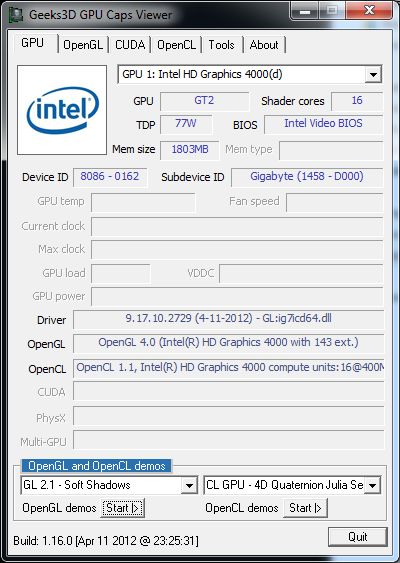
- Intel hd graphics 3000 opencl driver mac mac os x#
- Intel hd graphics 3000 opencl driver mac drivers#
- Intel hd graphics 3000 opencl driver mac driver#
- Intel hd graphics 3000 opencl driver mac pro#
- Intel hd graphics 3000 opencl driver mac software#
Intel hd graphics 3000 opencl driver mac pro#
continue to evaluate when and where OpenCL will intercept various products"Īnd is there secret Sandy Bridge IGP OpenCL support? Bit-tech got a quote from Intel that Sandy Bridge IGP OpenCL support was inbound sometime this year and if anyone would be motivated to get it done it'd be Apple.Īnd finally, does Apple now support hardware H.264 decoding on ATI or Intel GPUs? Previously, only a few nVidia GPUs were supported in Snow Leopard, such that the Arrandale MacBook Pro actually had to power up the 330M GT to decode H.264 wasting power compared to the perfectly fine Arrandale IGP if Apple just wrote the drivers.
Intel hd graphics 3000 opencl driver mac drivers#
"' will be releasing OpenCL graphics drivers to developers during the course of 2011. Given nVidia's GPGPU push can the HD 6490 still keep up with the 330M GT in OpenCL? How does the HD6750 do? Are the Sandy Bridge MacBook Pro's disproportionately faster than the Arrandale MacBook Pro to indicate that OS X has CPU OpenCL drivers that can take advantage of AVX? Probably not, and this will hopefully come with Lion. First, given Apple was the instigator of OpenCL, it'd be great if you could run some OpenCL benchmarks. I do have some additional questions though.
Intel hd graphics 3000 opencl driver mac software#
If you don't go through this process you'll never be able to read the core speeds accurately, which is why there's virtually no Mac software capable of this.įortunately MSR Tools exists, and it has a 32bit extension to allow it to peek at the MSRs.
Intel hd graphics 3000 opencl driver mac mac os x#
Under Mac OS X this requires installing an Extension (at least as far as I know) which gets messy.
Intel hd graphics 3000 opencl driver mac driver#
Linux already does this (/proc/cpu/0/msr), and on Windows it's fairly trivial to load a driver alongside an Admin-level application to do this(CPU-Z, etc). The issue with that is that it requires peeking at the Model-Specific Registers (MSRs), which require Ring 0 access or in other words you need a broker at the driver level to do it. To actually read the instantaneous speed of any given core, you need to peek at the CPU itself and count the cycles - Intel actually has a handy document detailing an algorithm to do this(1). So on the 15" low-end QC model you will always see 2.3GHz. Mac OS X's Sysctl reports the base speed of the processor, regardless whether Turbo Mode is active or not.

It's the same as the previous one, and unsurprisingly the data backs that conclusion up very well. There's shockingly little to say about it that we haven't said before.

We calibrated using the i1D2 and ColorEyes Display Pro same as we did before, then check with the GMB color checker card colors and get Delta E. 15-inch MBP with optional anti-glare screen (front) It's not surprising in the least that Apple is using the same panel there wasn't anything wrong with the old one.ġ3-inch Glossy MBP (back) vs. Before even starting to analyze display quality, I pulled the panel model out of EDID and wasn't surprised to see the same LTN154MT07 Samsung panel in the new 15" MBP as we did in the previous generation. We analyzed the 15" antiglare display on the new MacBook Pro since in all likelihood if you care about display quality you'll opt for the high res or high res antiglare option.


 0 kommentar(er)
0 kommentar(er)
